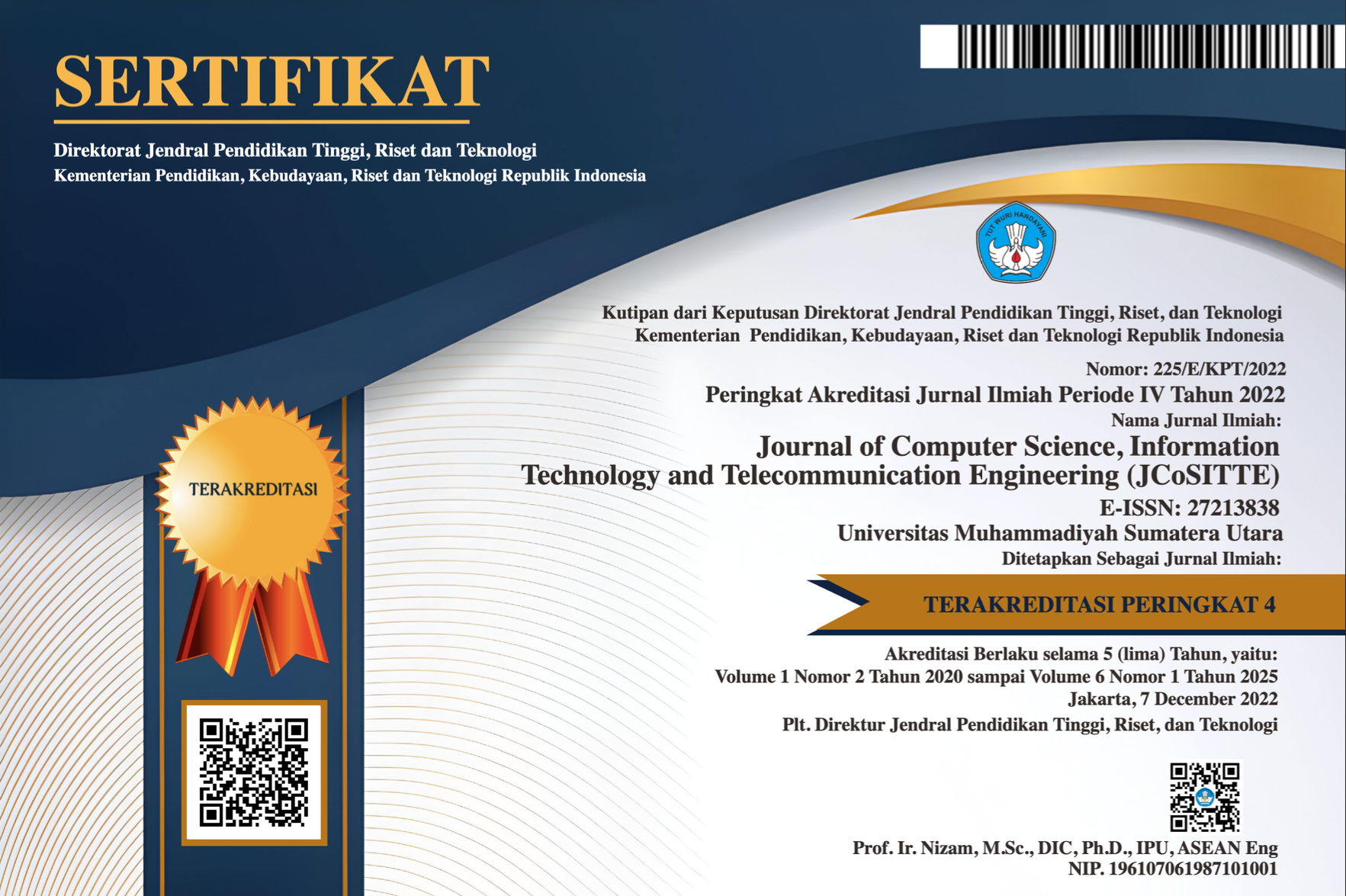Risk Management Analysis of Information Technology with Failure Mode and Effect Analysis Method at PT XYZ
Abstract
PT Kencana Inti Perkasa is a company engaged in the management of crude palm oil (Crude Palm Oil) which uses information technology for its smooth operations. In the company there are potential information technology risks that can have an impact on the company so that they need to be identified and given an assessment. Risk problems that occur in PT Kencana Inti Perkasa's information technology are damaged hardware, virus attacks, risks to data, and risks to the network. This research aims to produce RPN values, get a list of risk priorities and develop recommendations for control measures using the Failure Mode and Effect Analysis method. This process involves identifying failure modes, assessing the severity, frequency of occurrence, and detectability of each failure mode. The final result of this research found that there are 30 failure modes consisting of 4 risks categorized as High, 2 risks categorized as Medium, 22 risks categorized as Low, and 2 risks categorized as Very Low. The highest Risk Priority Number (RPN) value, 167.83 and in the High category, arises from the incorrect use of printers caused by human error, including technological resources that are routinely utilized by the company. Another risk in the High category is the slow network capacity with an RPN of 152.06. Furthermore, computer damage due to virus attacks obtained an RPN value of 122.26, while illegal access to PC information was also categorized as High with an RPN value of 121.09, which belongs to the company's vital technology resources. These findings indicate that these risks need to be the main focus in handling, considering the high RPN value indicates a significant level of urgency.
Full Text:
PDFReferences
Alijoyo, A., Wijaya, B., & Jacob, I. (2020). Failure Mode Effect Analysis Analisis Modus Kegagalan dan Dampak. CRMS Indonesia. www.lspmks.co.id
Ambiyar, & Muharika. (2019). Metodologi Penelitian Evaluasi Program (1st ed.). Alfabeta cv.
Amruddin, dkk, Muskananfola, I. L., Febriyanti, E., Pandie, F. R., & Goa, M. Y. (2022). Buku Metodologi Penelitian Kuantitatif dan Kualitatif (A. Munandar, Ed.). CV. MEDIA SAINS INDONESIA.
Anisah, D., Medina, N. Z., Nuraini, A. R., Siti, K. M., & Kraugusteelianan. (2021). Manajemen Risiko Sistem Informasi Rumah Sakit (Studi Kasus : Rumah Sakit EMC Tangerang). Seminar Nasional Mahasiswa Ilmu Komputer Dan Aplikasinya (SENAMIKA) . https://www.emc.id/id/hospitals/emc-
Harini Fajar Ningrum. (2022). Manajemen Risiko (Harini Fajar Ningrum, Ed.). MEDIA SAINS INDONESIA.
Lestari, I. P., Purwani, F., & Gunawan, C. E. (2024). Manajemen Risiko Aset Teknologi Informasi (1st ed.). Noer Fikri Offset .
Murdowo, S. (2023). Mengenal Lebih Dalam Tentang Virus-Virus Komputer dan Perilakunya. Jurnal INFOKAM, 19(1).
Permana, A. R., Anindita, R., Zainol, Z., & Quinn, A. (2025). Analisis Metode dan Teknologi untuk Perlindungan Data dan Informasi dari Ancaman Siber. Jurnal MENTARI: Manajemen, Pendidikan Dan Teknologi Informasi, 3(2), 137–146. https://doi.org/10.33050/mentari.v3i2.744
Putra, A. E., Wijaya, D. K., & Islahudin, N. (2023). Perbaikan proses printing menggunakan metode DMAIC dan 5S untuk mengurangi waste proses di UKM limit screen printing Semarang. JENIUS : Jurnal Terapan Teknik Industri, 4(1), 98–107. https://doi.org/10.37373/jenius.v4i1.468
Putu Sugih Arta, I., Gede Satriawan, D., Kadek Bagiana, I., Loppies, Y., Agusetiawan Shavab, F., Matari Fath Mala, C., Malik Sayuti, A., Agnes Safitri, D., Berlianty, T., Julike, W., Wicaksono, G., Marietza, F., Rustandi Kartawinata, B., & Utami, F. (2021). Manajemen Risiko Tinjauan Teori dan Praktis. Widina Bhakti Persada Bandung. www.penerbitwidina.com
Sabila, K., Rahayu, S., & Sumarni, T. (2024). Peningkatan Efisiensi Penggunaan Sumber Daya Jaringan Melalui Teknik Load Balancing. CEMERLANG : Jurnal Manajemen Dan Ekonomi Bisnis, 4(3), 31–41. https://doi.org/10.55606/cemerlang.v4i3.2989
Sani, A., & Pusparini, N. N. (2024). Riset Teknologi Informasi (Sebuah Pemahaman dan Implementasi) (1st ed., Vol. 1). PT Penamuda Media.
Taufik, A., Sudarsono, B. G., Budiyantara, A., Sudaryana, K., & Muryono, T. T. (2022). Pengantar Teknologi Informasi (J. Hutahaean & M. Amin, Eds.; 1st ed.). CV. Pena Persada.
Ulfa Mauludina, N., Mukaromah, S., & Wulansari, A. (2023). Pengukuran Tigkat Kapabilitas Manajemen Risiko Keamanan Informasi Pada Seksi Persandian Menggunakan COBIT 5. Prosiding Seminar Nasional Teknologi Dan Sistem Informasi (SITASI) 2023 Surabaya, 6–7.
Wicaksono, D. P., & Octaviani, A. (2023). Manajemen Risiko. Pustakabarupress.
Yuli Anita, S., Tanti Kustina, K., Wiratikusuma, Y., Sudirjo, F., Sari, D., Rupiwardani, I., Nugroho, L., Rakhmawati, I., Kesumawati Harahap, A., Anwar, S., Apriani, E., & Luh Ketut Ayu Sudha Sucandrawati, N. (2023). Manajemen Risiko (D. P. Sari, Ed.; 1st ed.). PT Global Eksekutif Teknologi. www.globaleksekutifteknologi.co.id
Zulvi, M. S. (2022). Jurnal Politeknik Caltex Riau Manajemen Risiko Teknologi Informasi Menggunakan Metode Fmea (Studi Kasus: Diskominfo Pemprov Riau). Jurnal Komputer Terapan, 8(2). https://jurnal.pcr.ac.id/index.php/jkt/
DOI: https://doi.org/10.30596/jcositte.v6i2.26392
Refbacks
- There are currently no refbacks.





.png)

